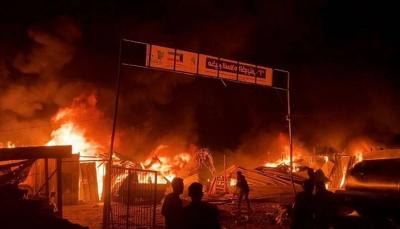Analysis by CNN of video footage from the site of the deadly Israeli airstrike on a Palestinian displacement camp in Rafah, along with reviews conducted by weapons experts, indicates that American-made munitions were used in the attack. CNN identified the geographic location of videos showing tents ablaze following the strike on the internally displaced persons camp known as the "Kuwait Peace Camp."
In a video shared on social media, which CNN identified geospatially to be from the same location by matching details such as the camp's entrance sign and the pavement on the ground, an American-made bomb tail, specifically a "GBU-39," can be seen, according to four explosives experts who reviewed the footage for the network.
Expert Chris Cob Smith told CNN that the "GBU-39," manufactured by Boeing, is a precision-guided bomb "designed to target strategically significant goals," resulting in low collateral damage. However, Smith, a former British Army artillery officer, added that "the use of any munitions, even of this size, will always pose risks in a densely populated area."
Trevor Paul, a former senior member of the U.S. Army Explosive Ordnance Disposal team who also identified the fragment as from a "GBU-39," explained how he reached his conclusion, stating, “The warhead of the munition is distinctive, and the guidance and wing section are very unique compared to other munitions.” He added, “The guidance and wing parts of munitions often remain even after the munition explodes, and when I saw the rear section, I immediately recognized it as a GBU-39 bomb.”
CNN's identification of the munitions corresponds with statements made by Israeli Army spokesperson Daniel Hagari during a press conference about the tragedy, where he mentioned that the airstrike, which aimed at senior Hamas leaders, utilized two munitions with small warheads containing 17 kilograms of explosives, adding that these bombs were "the smallest munitions our aircraft could use."
The conventional warhead of the "GBU-39" has an explosive payload of 17 kilograms, and additionally, the serial numbers found on the remnants match those of a manufacturer for "GBU-39" parts based in California, providing further evidence that the bombs were manufactured in the United States.




